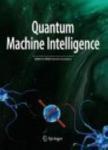版权所有:内蒙古大学图书馆 技术提供:维普资讯• 智图
内蒙古自治区呼和浩特市赛罕区大学西街235号 邮编: 010021

作者机构:Univ Technol Sydney Fac Engn & Informat Technol Ctr Quantum Software & Informat Ultimo NSW 2007 Australia Ain Shams Univ Fac Engn Elect & Commun Engn Dept Cairo Egypt Ain Shams Univ Fac Engn Engn Phys & Math Dept Cairo Egypt Shanghai Maritime Univ Coll Informat Engn Shanghai Peoples R China
出 版 物:《QUANTUM MACHINE INTELLIGENCE》 (Quantum Mach. Intell.)
年 卷 期:2019年第1卷第3-4期
页 面:97-111页
核心收录:
基 金:Australian Government Research Training Program Scholarship National Natural Science Foundation of China [61463016, 61763014] National Key RD Plan [SQ2018YFC120002] "Science and technology innovation action plan" of Shanghai in 2017
主 题:Quantum-inspired algorithms Coherent states Quantum harmonic oscillator Signal processing
摘 要:The probabilistic nature of quantum particles, state space, and the superposition principle are among the important concepts in quantum mechanics. A framework was previously developed by the authors that allowed to take advantage of these quantum aspects in the field of image processing. This was done by modeling each image s pixel by a two-state quantum system which allowed efficient single-object segmentation. However, the extension of the framework to multi-object segmentation would be highly complex and computationally expensive. In this paper, we propose a classical image segmentation algorithm inspired by the continuous-variable quantum theory that overcomes the challenges in extending the framework to multi-object segmentation. By associating each pixel with a quantum harmonic oscillator, the space of coherent states becomes continuous. Thus, each pixel can evolve from an initial state to any of the continuous coherent states under the influence of an external resonant force. The Hamiltonian operator is designed to account for this force and is derived from the features extracted at the pixel. Therefore, the system evolves from an initial ground state to a final coherent state depending on the image features. Finally by calculating the fidelity between the final state and a set of reference states representing the objects in the image, the state with the highest fidelity is selected. The collective states of all pixels produce the final segmentation. The proposed method is tested on a database of synthetic and natural images, and compared with other methods. Average sensitivity and specificity of 97.86% and 99.61% were obtained respectively indicating the high segmentation accuracy of the algorithm.